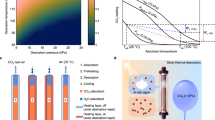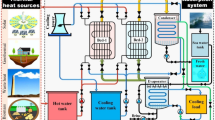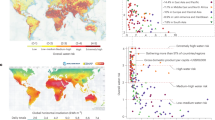Abstract
Water plays a pivotal role in direct air capture technologies, impacting materials, regeneration processes and product streams. CO2 removal methods, including absorption, adsorption and electrochemical techniques, encounter challenges associated with water, thus reducing their efficacy. Water fluxes into and out of aqueous solvents affect the concentration and overall capture performance. Solid adsorbents co-adsorb water in greater quantities than CO2 and will require effective strategies to address the substantial energy penalty associated with water desorption each cycle. Water-management strategies are imperative for economic viability and minimizing the environmental impact, but the high energy intensity necessitates heat recovery techniques. Feed dehydration can be combined with strategic heat integration of process streams and standard recovery techniques for front-end water management. For back-end approaches, mechanical vapor compression is a viable solution for coupling heat integration with water management, and we highlight potential heat recovery benefits of three implementation methods. Further research into variable climate conditions and water quality impacts is essential for the success of direct air capture technologies.

This is a preview of subscription content, access via your institution
Access options
Subscribe to this journal
Receive 12 digital issues and online access to articles
118,99 € per year
only 9,92 € per issue
Buy this article
- Purchase on SpringerLink
- Instant access to full article PDF
Prices may be subject to local taxes which are calculated during checkout




Similar content being viewed by others
References
Young, J. et al. The cost of direct air capture and storage can be reduced via strategic deployment but is unlikely to fall below stated cost targets. One Earth 6, 899–917 (2023).
Küng, L. K. et al. A roadmap for achieving scalable, safe, and low-cost direct air carbon capture and storage. Energy Environ. Sci. 16, 4280–4304 (2023).
Erans, M. et al. Direct air capture: process technology, techno-economic and socio-political challenges. Energy Environ. Sci. 15, 1360–1405 (2022).
Sabatino, F. et al. A comparative energy and costs assessment and optimization for direct air capture technologies. Joule 5, 2047–2076 (2021).
Kasturi, A. et al. An effective air-liquid contactor for CO2 direct air capture using aqueous solvents. Sep. Purif. Technol. 324, 124398 (2023).
Custelcean, R. Direct air capture of CO2 using solvents. Annu. Rev. Chem. Biomol. Eng. 13, 217–234 (2022).
Keith, D. W., Holmes, G., Angelo, D. S. & Heidel, K. A process for capturing CO2 from the atmosphere. Joule 2, 1573–1594 (2018).
Sanz-Perez, E. S., Murdock, C. R., Didas, S. A. & Jones, C. W. Direct capture of CO2 from ambient air. Chem. Rev. 116, 11840–11876 (2016).
An, K. J., Farooqui, A. & McCoy, S. T. The impact of climate on solvent-based direct air capture systems. Appl. Energy 325, 119895 (2022).
Rosa, L., Sanchez, D. L., Realmonte, G., Baldocchi, D. & D'Odorico, P. The water footprint of carbon capture and storage technologies. Renew. Sustain. Energy Rev 138, 110511 (2021).
Negative Emissions Technologies and Reliable Sequestration: A Research Agenda (National Academies Press, 2019).
Hospital-Benito, D., Moya, C., Gazzani, M. & Palomar, J. Direct air capture based on ionic liquids: from molecular design to process assessment. Chem. Eng. J. 468, 143630 (2023).
Doblinger, S., Donati, T. J. & Silvester, D. S. Effect of humidity and impurities on the electrochemical window of ionic liquids and its implications for electroanalysis. J. Phys. Chem. C 124, 20309–20319 (2020).
Min, Z. J. et al. How does the moisture affect CO2 absorption by a glycinate ionic liquid? ACS Sustain. Chem. Eng. 9, 853–862 (2021).
Huang, Y. J. et al. Reply to the correspondence on ‘preorganization and cooperation for highly efficient and reversible capture of low-concentration CO2 by ionic liquids. Angew. Chem. Int. Ed. 58, 386–389 (2019).
Renfrew, S. E., Starr, D. E. & Strasser, P. Electrochemical approaches toward CO2 capture and concentration. ACS Catal. 10, 13058–13074 (2020).
Sabatino, F., Gazzani, M., Gallucci, F. & Annaland, M. V. Modeling, optimization and techno-economic analysis of bipolar membrane electrodialysis for direct air capture processes. Ind. Eng. Chem. Res. 61, 12668–12679 (2022).
Diederichsen, K. M. et al. Electrochemical methods for carbon dioxide separations. Nat. Rev. Methods Primers 2, 68 (2022).
Wang, M., Herzog, H. J. & Hatton, T. A. CO2 capture using electrochemically mediated amine regeneration. Ind. Eng. Chem. Res. 59, 7087–7096 (2020).
Eisaman, M. D. et al. CO2 separation using bipolar membrane electrodialysis. Energy Environ. Sci. 4, 1319–1328 (2011).
Liu, Y. Y., Ye, H. Z., Diederichsen, K. M., Van Voorhis, T. & Hatton, T. A. Electrochemically mediated carbon dioxide separation with quinone chemistry in salt-concentrated aqueous media. Nat. Commun. 11, 2278 (2020).
Seo, H., Rahimi, M. & Hatton, T. A. Electrochemical carbon dioxide capture and release with a redox-active amine. J. Am. Chem. Soc. 144, 2164–2170 (2022).
Seo, H. & Hatton, T. A. Electrochemical direct air capture of CO2 using neutral red as reversible redox-active material. Nat. Commun. 14, 313 (2023).
Kolle, J. M., Fayaz, M. & Sayari, A. Understanding the effect of water on CO2 adsorption. Chem. Rev. 121, 7280–7345 (2021).
Ben Said, R., Kolle, J. M., Essalah, K., Tangour, B. & Sayari, A. A unified approach to CO2-amine reaction mechanisms. ACS Omega 5, 26125–26133 (2020).
Holmes, H. E. et al. Optimum relative humidity enhances CO2 uptake in diamine-appended M2(dobpdc). Chem. Eng. J. 477, 147119 (2023).
Burtch, N. C., Jasuja, H. & Walton, K. S. Water stability and adsorption in metal-organic frameworks. Chem. Rev. 114, 10575–10612 (2014).
Kusgens, P. et al. Characterization of metal-organic frameworks by water adsorption. Microporous Mesoporous Mater. 120, 325–330 (2009).
Holmes, H. E., Lively, R. P. & Realff, M. J. Defining targets for adsorbent materials performance to enable viable BECCS processes. JACS Au 1, 795–806 (2021).
Song, M. Y. et al. Cold-temperature capture of carbon dioxide with water coproduction from air using commercial zeolites. Ind. Eng. Chem. Res. https://doi.org/10.1021/acs.iecr.2c02041 (2022).
Shi, X. Y. et al. Moisture-driven CO2 sorbents. Joule 4, 1823–1837 (2020).
Wang, T., Lackner, K. S. & Wright, A. Moisture swing sorbent for carbon dioxide capture from ambient air. Environ. Sci. Technol. 45, 6670–6675 (2011).
McQueen, N., Kelemen, P., Dipple, G., Renforth, P. & Wilcox, J. Ambient weathering of magnesium oxide for CO2 removal from air. Nat. Commun. 11, 3299 (2020).
Gadikota, G. Carbon mineralization pathways for carbon capture, storage and utilization. Commun. Chem 4, 23 (2021).
Sinha, A., Darunte, L. A., Jones, C. W., Realff, M. J. & Kawajiri, Y. Systems design and economic analysis of direct air capture of CO2 through temperature vacuum swing adsorption using MIL-101(Cr)-PEI-800 and mmen-Mg2(dobpdc) MOF adsorbents. Ind. Eng. Chem. Res. 56, 750–764 (2017).
Ritter, J. A., Ebner, A. D. & Holland, C. E. Temperature-vacuum swing adsorption process for capture of CO2. US patent 20200001225 (2021).
Wu, X. W., Krishnamoorti, R. & Bollini, P. Technological options for direct air capture: a comparative process engineering review. Annu. Rev. Chem. Biomol. Eng. 13, 279–300 (2022).
Joel, A. S., Wang, M. H., Ramshaw, C. & Oko, E. Modelling, simulation and analysis of intensified regenerator for solvent based carbon capture using rotating packed bed technology. Appl. Energy 203, 11–25 (2017).
Drechsler, C. & Agar, D. W. Simulation and optimization of a novel moving belt adsorber concept for the direct air capture of carbon dioxide. Comput. Chem. Eng. 126, 520–534 (2019).
Leonzio, G. & Shah, N. L. Innovative process integrating air source heat pumps and direct air capture processes. Ind. Eng. Chem. Res. 61, 13221–13230 (2022).
Peacock, J., Cooper, R., Waller, N. & Richardson, G. Decarbonising aviation at scale through synthesis of sustainable e-fuel: a techno-economic assessment. Int. J. Hydrogen Energy 50, 869–890 (2024).
Sendi, M., Bui, M., Dowell, N. M. & Fennell, P. Geospatial analysis of regional climate impacts to accelerate cost-efficient direct air capture deployment. One Earth 5, 1153–1164 (2022).
Wiegner, J. F., Grimm, A., Weimann, L. & Gazzani, M. Optimal design and operation of solid sorbent direct air capture processes at varying ambient conditions. Ind. Eng. Chem. Res. 61, 12649–12667 (2022).
Massen-Hane, M., Diederichsen, K. M. & Hatton, T. A. Engineering redox-active electrochemically mediated carbon dioxide capture systems. Nat. Chem. Eng. 1, 35–44 (2024).
Acknowledgements
H.E.H. thanks the National Science Foundation Graduate Research Fellowship Program for financial support. This research was funded by the Advanced Research Projects Agency-Energy of the US Department of Energy under award no. DEAR0001414. We thank C. W. Jones (Georgia Institute of Technology) for useful discussions on this topic.
Author information
Authors and Affiliations
Contributions
All authors contributed to discussions, analysis, and review and editing of the manuscript. R.P.L. contributed to conceptualization and visualization, M.J.R. to conceptualization and formal analysis, and H.E.H. to visualization, formal analysis and writing of the original draft.
Corresponding authors
Ethics declarations
Competing interests
The authors declare no competing interests.
Peer review
Peer review information
Nature Chemical Engineering thanks Costas Tsouris and Tao Wang for their contribution to the peer review of this work.
Additional information
Publisher’s note Springer Nature remains neutral with regard to jurisdictional claims in published maps and institutional affiliations.
Rights and permissions
Springer Nature or its licensor (e.g. a society or other partner) holds exclusive rights to this article under a publishing agreement with the author(s) or other rightsholder(s); author self-archiving of the accepted manuscript version of this article is solely governed by the terms of such publishing agreement and applicable law.
About this article
Cite this article
Holmes, H.E., Realff, M.J. & Lively, R.P. Water management and heat integration in direct air capture systems. Nat Chem Eng 1, 208–215 (2024). https://doi.org/10.1038/s44286-024-00032-6
Received:
Accepted:
Published:
Issue Date:
DOI: https://doi.org/10.1038/s44286-024-00032-6
This article is cited by
-
Powering Direct Air Capture: Overview of Existing Concepts and the Overlooked Role of Concentrated Solar Thermal Technologies
Current Sustainable/Renewable Energy Reports (2025)
-
Accelerating climate technologies through the science of scale-up
Nature Chemical Engineering (2024)



